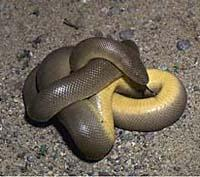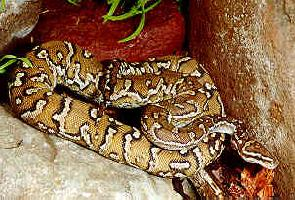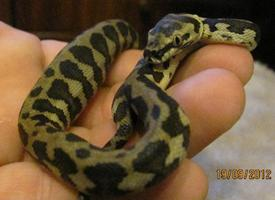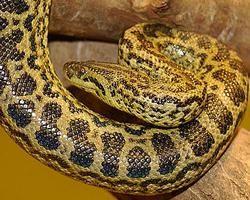
Váhy a míry
| Délka | od 40 do 85 cm |
|---|
Biologická data
| Délka života | 15 r |
|---|---|
| Počet mláďat | 2 - 10 |
Popis zvířete
The Rubber boa (Charina bottae) is a distinctive species of snake belonging to the Boidae family, known for its small size, docile nature, and unique physical characteristics that set it apart from many other snakes. Native to the western United States and British Columbia, Canada, this intriguing creature has adapted to a variety of habitats, ranging from grasslands and chaparral to forested areas and even high-altitude regions.One of the most striking features of the Rubber boa is its smooth, shiny skin, which has a rubbery texture, hence its name. This skin is typically a uniform color that can range from olive-green, tan, to dark brown, providing excellent camouflage against the forest floor and underbrush. The boa's small size, with adults usually reaching only 60 to 84 cm (about 24 to 33 inches) in length, further aids in its ability to remain undetected in its natural environment.
The Rubber boa has a very distinctive head and tail, which are similarly blunt and can make it challenging to distinguish the head from the tail when the snake is curled up. This feature serves as a defense mechanism, allowing the boa to present its tail to predators while protecting its head. The tail is equipped with a hard, keratinized "spur" that the snake can use to ward off attackers.
Rubber boas are known for their gentle disposition. When handled by humans, they rarely bite and are often described as having a calm and placid temperament. This behavior, combined with their smooth skin and ease of care, makes them popular pets among snake enthusiasts.
In terms of diet, Rubber boas are carnivorous, primarily preying on small mammals such as mice, voles, and shrews. They are constrictors, employing their muscular bodies to suffocate their prey before consumption. Additionally, they have been known to eat bird eggs, small birds, and lizards, demonstrating a degree of dietary flexibility.
Reproduction in Rubber boas involves viviparity, meaning they give birth to live young rather than laying eggs. Females reproduce every other year, with litter sizes ranging from 2 to 8 young. This reproductive strategy allows the Rubber boa to give birth in environments that might be too cold for egg incubation, thus extending their range into cooler climates.
Rubber boas are primarily nocturnal, especially during the warmer months, to avoid overheating. During the day, they can often be found hiding under rocks, logs, or leaf litter. In colder weather, they are known to brumate, a process similar to hibernation, in communal dens that can sometimes include other snake species.
Despite their resilience and adaptability, Rubber boas face threats from habitat destruction, road mortality, and illegal collection for the pet trade. Conservation efforts are crucial to ensure the survival of this unique species in its natural habitat.
In summary, the Rubber boa (Charina bottae) is a fascinating and gentle species, admired for its unique appearance, docile nature, and ecological adaptability. Its presence in a diverse range of habitats underscores the importance of preserving natural ecosystems for the continued survival of such distinctive wildlife.
Podobná zvířata
Nové fotografie zvířat
Top 10 zvířat
- Common house mosquito (Culex pipiens)
- Common cockchafer (Melolontha melolontha)
- Colossal squid (Mesonychoteuthis hamiltoni)
- Hooded merganser (Lophodytes cucullatus)
- Australian box jelly (Chironex fleckeri)
- Fruit fly (Drosophila melanogaster)
- Common reed warbler (Acrocephalus scirpaceus)
- Elephant hawk moth (Deilephila elpenor)
- Moustached guenon (Cercopithecus cephus)
- Diana monkey (Cercopithecus diana)


